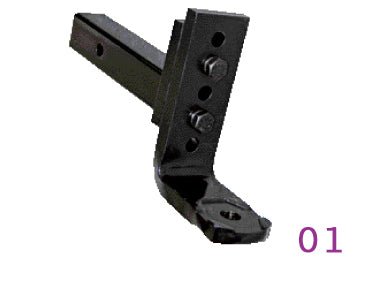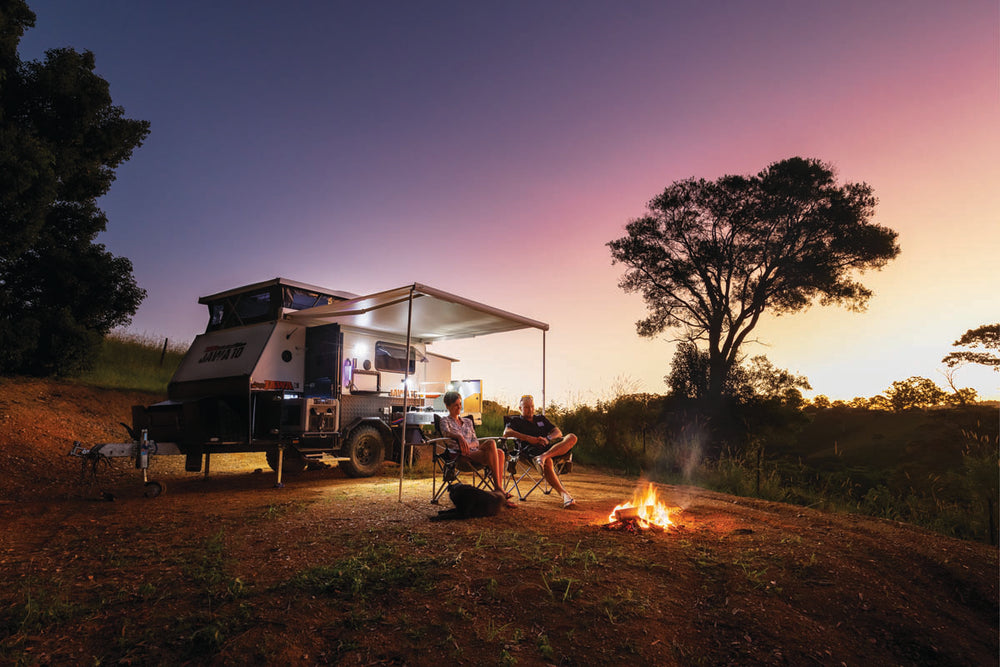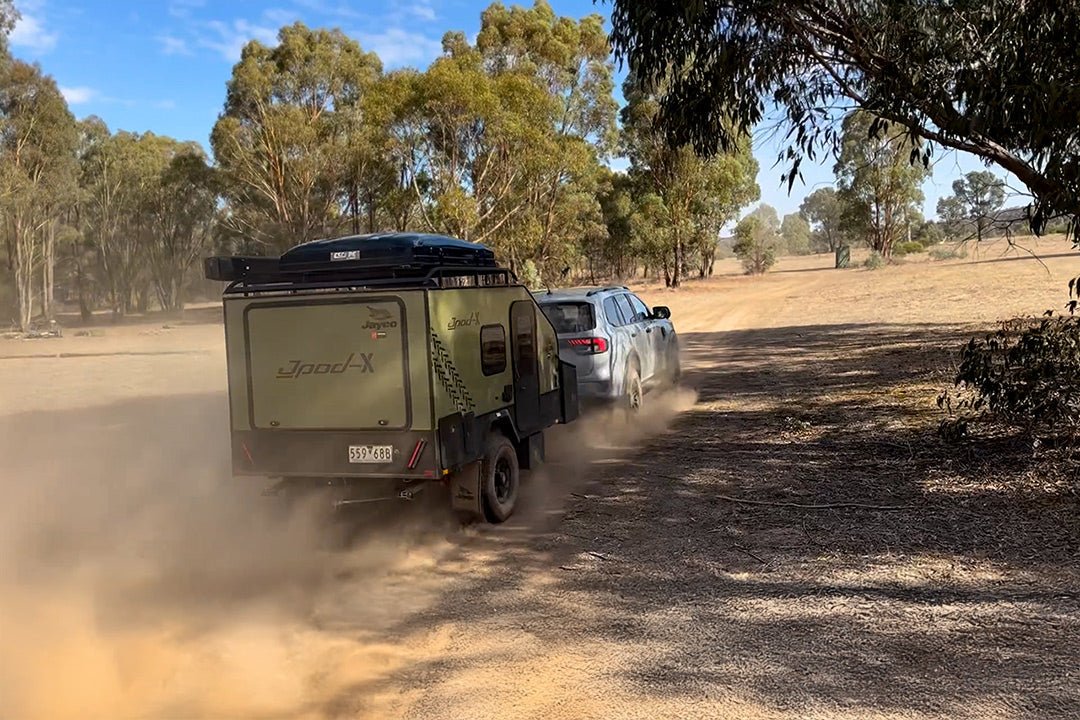20 ways to level your rig

PROFESSIONALS IN THE caravan and trailer industries need little more than a glance to tell whether a tow vehicle and caravan combination is safe for travel. The standing arrangement of a rig conveys this information immediately. If the rear of the tow vehicle is higher than it ought to be, one can assume the rig will act in an unwieldy manner at speed. Why? Because with too little weight on the car’s rear axle, the caravan will push the rear of the tow vehicle around. A small correction – to avoid a pothole, for instance – and the caravan will start to push the car’s rear end sideways. The driver may then feel that and try to correct, which will cause the car to move quickly in another direction. In a matter of seconds the caravan takes on the properties of a pendulum in a grandfather clock, swinging this way and that. Once sway (also called “fish-tailing”) begins while travelling, it is very difficult to stop.
On the other hand, if the nose of the car is higher than is natural the observer will accurately predict that under firm to ‘panic’ braking, the front wheels will lose traction and probably lock up. What’s more, steering will be compromised. These issues are greatly magnified if the rig is travelling on a wet road or a loose surface, such as gravel.
So what we have in each case – ball down or ball up – is a rig that doesn’t look right, doesn’t drive right, and has the potential to become uncontrollable.
GETTING LEVEL
The jockey wheel in the image below has been set to the point where the caravan is level. However, in order for the van to be connected to the tow vehicle, either the connection point on the ute needs to be elevated, or the coupling on the caravan fixed to a plate level with the bottom of the chassis rail.
There are numerous ways to meet this need – some complex, others relatively simple. To some extent the complexity of the solution depends on the distance the connection point must be raised or lowered.
There is also the issue of the amount of weight to be handled – some of the simple solutions have stress limits imposed by the accessory manufacturer.
NATURALLY LEVEL
The best solution is to start off by matching the heights of the van and the tow vehicle so they are naturally level. If you can manage that, and if both units are operating comfortably within their legal weight limits, you are not likely to encounter levelling problems.
LARGER WHEELS
If the trailer is a little low, consider fitting wheels that are one size larger. Many vans may have been constructed when 13in wheels were the standard, but it is possible that 14in wheels could be fitted. The same applies to 14in and 15in wheels.
This will depend on the compatibility of wheel stud patterns, enough space in the well for the larger wheel, and adequate space between axles to accommodate the larger wheels without them touching each other.
A larger wheel will rotate slower than a small wheel. Conversely, if the van is a little high, smaller wheels or lower profile tyres would lower it slightly.
ADJUSTABLE HITCH
To correctly set a caravan for towing, use a height-adjustable hitch (picture 01). This will give as much as 300mm in height variation by having it inserted into the receiver hitch, or rotated 180°.
PRESSURE AIRBAGS
If you have a tow vehicle with soft rear suspension, fit adjustable pressure airbags so it sits level before the van is attached. Only after this requirement is satisfied would you connect the caravan and any essential towing aids.
Before fitting the airbags, make sure the vehicle manufacturer’s axle and overall weights limits are not exceeded.
WEIGHT DISTRIBUTION HITCH
If the trailer and tow vehicle sag at the connection point, fit a weight distribution hitch (picture 02) to return load to the front of the tow vehicle.
Professional advice should be sought here, as fitting the weight distribution system by yourself may not be a sufficient correction.
TYRE PROFILES
If either the van or tow vehicle has low profile tyres, higher profile tyres will alter overall height. For example, a pair of identical 16in wheels can be fitted with tyres of differing profiles. If a tyre has a higher profile, there will be a greater distance between the rim and the tread that contacts the road.
Fitting a lower profile tyre onto the wheel will lower the caravan, and fitting a higher profile tyre will elevate it. Because the overall diameter changes, this will affect the rotation speed and cause the speedometer and odometer to give a different reading.
COUPLING POSITION
If the van’s tail is down, relocating the coupling mount to a position on top of the A-frame will lower the nose of the van and slightly raise the tail.
Have the coupling fitted into the centreline of the chassis, instead of above or below the rails, to raise or lower the rear of the van.
Fitting the coupling below the A-frame line will lower the van’s rear.
RISER SECTION
To lift the entire caravan, have a riser section added under the chassis. This strategy is often employed by caravan builders as an inexpensive way to transform a standard van to an ‘offroad’ or ‘rough-road’ model with extra under-body ground clearance.
SPRING HANGER ARMS
An alternative to having a riser section added is to use longer spring hanger arms to elevate the caravan chassis.
Inappropriately long or poorly designed hanger arms can fail under stress, so this modification needs professional oversight.
DROP AXLE
To decrease the overall height of a van, fit a drop axle (picture 03). The hitch will have to be lowered along with the rest of the van to maintain a level appearance.
STRAIGHT AXLE
If you wish to increase inadequate caravan ground clearance, exchange the existing drop or overlaid axle for a straight one.
Drop or overlaid axles bring the body of the van closer to the ground, while a straight axle puts the rear of the van higher. An adjustment of the coupling height will be needed to keep the unit level.
UNDERSLUNG SUSPENSION
To lower a van with a straight beam axle, have the axle fitted above the spring pack. This is called an “underslung” suspension, with the spring leaves slung under the axle.
TOW BALL
Using a tow ball with a 25mm or 50mm spacer collar is an inexpensive option for raising the nose of the van. Make sure any ball purchased is stamped with its rating and manufacturer name – a legal requirement.
AIRBAG SUSPENSION
If the van has its tail down when loaded, but is okay when not loaded, there are two possible remedies: remove some of the load from the van; or consider fitting airbag suspension (picture 04).
This type of suspension maintains height regardless of load. Instead of a spring, the heavy-duty airbag is inflated to an appropriate pressure to provide the ride firmness and height required.
REDUCE OVERHANG
If you find the towbar moves too close to the ground when the van is connected, and you have a long reach from under the ute tray or from the chassis to the ball, it may be because of excessive leverage on the towbar.
It will be necessary to reduce the overhang by either shortening the tray or doing whatever is needed to effectively move the rear axle closer to the tow ball.
RE-SET SPRINGS
Coil and leaf springs sag over time, which alters the height of the vehicle they support. Both types of spring can easily be re-set and restored to their original height.
LOAD DISTRIBUTION
For a balanced-looking rig, ensure the loads in the tow vehicle and the van are properly distributed. The yellow zones in the diagram (picture 05) are the areas the vehicle manufacturers expected and designed their products to be carrying payload.
RECEIVER-STYLE HITCH
This type of hitch permits the user to rotate the towbar tongue 180°, raising or lowering ball height by around 75-100mm. Note some manufacturers quote different downloads for the same tongue when it is in the “up” and “down” positions.
DROP TONGUE
A fixed drop tongue will lower the front of a van by as much as 150mm.
TANDEM AXLES
A single-axle caravan is a lot like a see-saw on wheels, with the pivot point being the axle. To reduce a ‘see-saw’ effect and more easily keep the van level, swap the single-axle van for a tandem van, which has its load across two axles.
Tandem-axle caravans have greater stability, and because they have two pairs of wheels running parallel, are more likely to track in a straight line and avoid the tendency to fish-tail.
CORRECT WEIGHT
All vehicle manufacturers provide information regarding axle loadings. Towbar manufacturers specify the legal load limits of their equipment. When looking at rigs which dip at the connection point, check the weight being imposed on the towbar and on the rear axle.
Rear axle weight can be established at a registered weighbridge, and ball weight is easily checked with ball weight scales.
e







